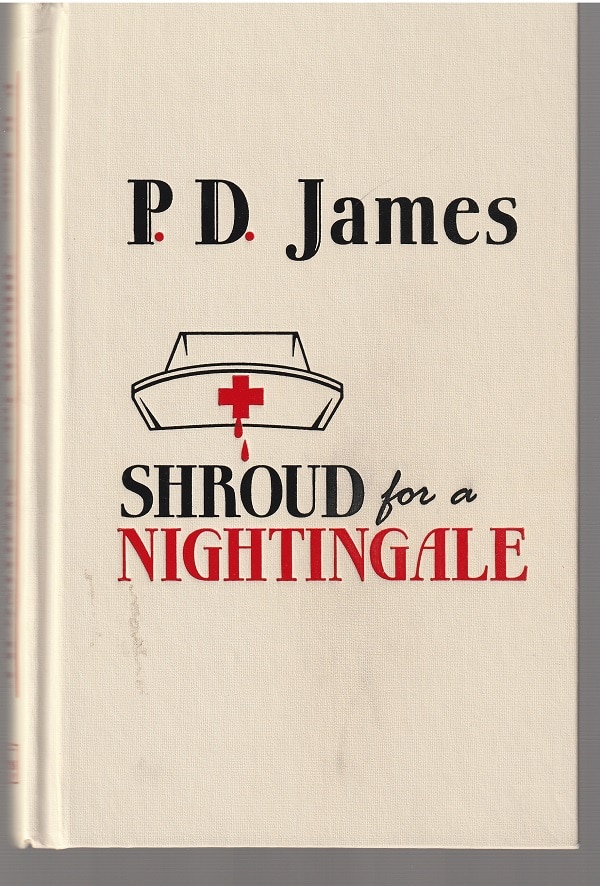Shroud for a Nightingale, published in 1971, was the fourth crime novel by P.D. James, the fourth of a series centered on Scotland Yard detective Adam Dalgliesh that would eventually total 14.
It was much better than the three previous books — Cover Her Face (1962), A Mind to Murder (1963), and Unnatural Causes (1967) — but not as good as the ones that would follow.
Shroud for a Nightingale is marred by an extremely complex solution to the puzzle of the separate murders of two student nurses and by the way the unfolding of that solution lands rather clunkily across 20 pages at the end of the novel. James would learn better.
Those flaws aside, though, the novel is a pleasure to read for the insights into human nature that James brings to her task and for her rich and vivid language in describing humans and the way they act around each other.
“A blasphemous liturgy”
For instance, Matron Mary Taylor, the head of nursing and the single strongest force at the John Carpendar Hospital outside of London, is one of those hyper-competent, compassionate leaders on whom the staff routinely leans. Yet, as James describes it, Taylor finds the performance draining:
They all wanted to have just a word about the problem. They all went away feeling better. Hear what comfortable words matron saith. Her whole working life seemed a blasphemous liturgy of reassurance and absolution. And how much easier both to give and to accept was this bland milk of human kindness than the acid of truth. She could imagine the blank incomprehension, the resentment with which they would greet her private credo.
“I haven’t anything to offer. There isn’t any help. We are all alone, all of us from the moment of birth until we die. Our past is our present and our future. We have to live with ourselves until there isn’t any more time left. If you want salvation look to yourself. There’s nowhere else to look.”
“The full enormity of the crime”
Or consider Dalgliesh’s interview with Miss Martha Collins, the housekeeper at Nightingale House, the nurse training school at the hospital.

She is, writes James, “ a thin, brown-skinned woman, brittle and nobbly as a dead branch, who looked as if the sap had long since dried in her bones.” When Collins arrives for the questioning, she sits down “with anticipatory malevolence” and never once smiles during the half hour.
Dalgliesh wondered whether her acidulated tone and perversely unattractive appearance were part of a calculated persona. Perhaps some forty years earlier she had decided to become a hospital character, the beloved tyrant of fiction, treating everyone from the matron to the junior maid with equal irreverence, and had found the characterization so successful and satisfying that she had never managed to drop it.
The policeman rather enjoys talking with her and watching her performance. At the end, when they talk about the bottle of disinfectant that was the poison that killed the first nurse, Collins forcefully says, “And now I’ll tell you something, Mr. Detective.”
Raising “her thin rump from the chair,” she leans forward with her beady eyes and tells him in no uncertain terms, “No one had any right to take that bottle out of the lavatory without my permission or to use it for any other purpose except for cleaning the lavatory bowl. Nobody!”
To which, James drolly notes:
It was apparent where in Miss Collins’s eyes the full enormity of the crime had lain.
“A witch’s plaything”
One more example will suffice. It comes as the police are investigating the second murder, as various police officers are dusting for fingerprints and searching for clues and taking photographs of the dead body.
There was an explosion of light, and the image of the dead girl leapt up at them and lay suspended in air, burning itself on Dalgliesh’s retina.
Colour and shape were intensified and distorted in that cruel, momentary glare. The long black hair was a tangled wig against the whiteness of the pillows; the glazed eyes were exophthalmic marbles, as if rigor mortis were squeezing them out of their sockets; the skin was very white and smooth, looking repulsive to the touch, an artificial membrane, tough and impermeable as vinyl.
Dalgliesh blinked, erasing the image of a witch’s plaything, a grotesque puppet casually tossed against the pillow. When he next looked at her, she was again a dead girl on a bed; no more and no loss.
There is much going on in that description. For one thing, a closely observed moment, clearly rendered in words on a page. For another, an unstated meditation on the loss of control and dignity that death brings.
Both and much more are contained in the two images that the moment of the photographer’s flash brings — the body transformed into “a witch’s plaything, a grotesque puppet.”
James was that rare mystery writer and, for that matter, rare writer who could see and feel in the routine the deeper waters of life and loss.
Patrick T. Reardon
6.17.21
Written by : Patrick T. Reardon
For more than three decades Patrick T. Reardon was an urban affairs writer, a feature writer, a columnist, and an editor for the Chicago Tribune. In 2000 he was one of a team of 50 staff members who won a Pulitzer Prize for explanatory reporting. Now a freelance writer and poet, he has contributed chapters to several books and is the author of Faith Stripped to Its Essence. His website is https://patricktreardon.com/.
